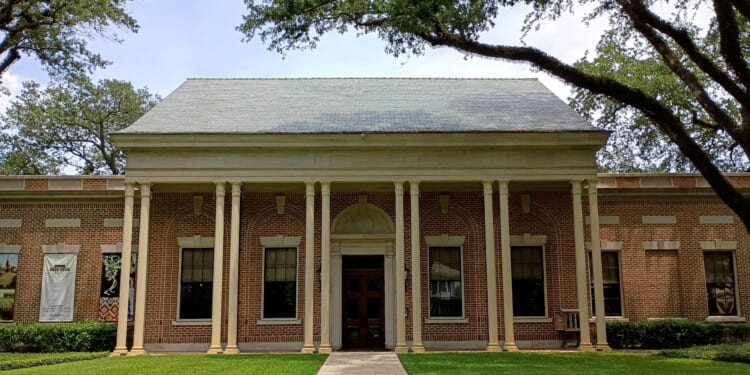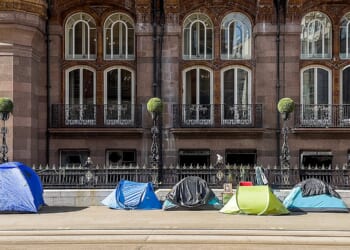I just returned from a girls’ trip to Laurel, Mississippi, the South’s self-styled “City Beautiful,” a small town made famous by HGTV’s “Home Town” — the popular home renovation show hosted by Erin and Ben Napier. I went to scope out historic fixer-uppers, hoping to make one my own.
Standing on the creaky porch of a 1910 Craftsman bungalow, built for a sawmill manager during the lumber boom of the late 1890s to early 1920s, I felt its history. This house, shaped by Laurel’s embrace of the City Beautiful Movement introduced at the 1893 World’s Columbian Exposition, was part of a vision that used elegant architecture, tree-lined streets, and open parks to spark civic pride and community. Restoring this bungalow, which looks out onto one of Laurel’s historic parks, would mean joining a revival that’s bringing new life to this town while echoing a national push for architecture that fosters civic pride and national identity.
Photos of the bungalow didn’t prepare me for its reality: sagging floors, broken fireplaces, cracked paint — a fixer-upper’s fever dream. It’s a gut job, no question. But I’m not entirely rational about this. I arrived with hope and a touch of romance, caught up in the revival driven by the Napiers, Laurel’s own version of Chip and Joanna Gaines.
Looking past the decay, I saw sturdy columns, heavy oak doors, original heart-pine floors, and a clawfoot tub with potential. I could picture what this home once was and could be again with serious work. More than that, restoring it wouldn’t just give me a beautiful place to live; it’d tie me to Laurel’s revival, where local businesses are thriving, craftsmen are finding steady work, and pride in the town’s heritage is growing, along with hope for its future.
Laurel’s founders, like Catherine Marshall Gardiner, leaned into the City Beautiful vision, planting oaks along Fifth Avenue and building the Beaux-Arts mansion that’s now the Lauren Rogers Museum of Art. They designed broad streets and public spaces like Gardiner Park, right by my bungalow, to encourage community and leisure. This vision wasn’t just local dreaming — it drew from a grand European model that reshaped cities worldwide.
The City Beautiful Movement was inspired by Baron Georges-Eugène Haussmann’s radical transformation of Paris in the mid-19th century. Haussmann’s vision — wide boulevards, uniform neoclassical facades, and verdant parks — turned a chaotic medieval city into a beacon of order and beauty, influencing urban reforms across Europe, including Budapest’s grand Andrássy Avenue.
American planners, captivated by these European models at the 1893 World’s Columbian Exposition in Chicago, brought this ethos to cities like Laurel, where founders like Gardiner echoed Haussmann’s emphasis on elegant streets and public spaces to foster civic pride. The Exposition’s “White City,” with its Beaux-Arts splendor, inspired Laurel’s broad avenues and parks, designed to unify communities and elevate daily life. This transatlantic thread, from Paris to Budapest to small-town Mississippi, shaped my bungalow’s neighborhood, where sturdy oaks and open greens still whisper of a movement that saw beauty as a force for social good.
The 2025 “Making Federal Architecture Beautiful Again” executive order, signed by President Trump, revives this Haussmann-inspired vision, channeling the City Beautiful Movement’s spirit into a renewed call for classical architecture across America. Just as Haussmann’s Paris used Greco-Roman designs to inspire awe and unity, the order seeks to replace the ugly Brutalism of federal buildings.
The executive order promotes classical Greco-Roman and Neoclassical designs for projects like Hartford’s $150 million Ribicoff Federal Building and Fort Lauderdale’s $196 million courthouse. Moving away from stark concrete structures like the FBI’s J. Edgar Hoover Building, it aligns with the 72 percent of Americans who prefer classical styles — buildings that feel grand yet approachable, rooted in craftsmanship and shared values.
The National Mall in D.C., stretching from the Capitol to the Lincoln Memorial, captures the City Beautiful spirit with its tree-lined paths, classical monuments, and Smithsonian museums. It’s a vibrant civic space, hosting national events and reflecting our shared history, perfectly in sync with the 2025 order’s goal to create enduring, uplifting buildings like historic courthouses or the Capitol’s dome.
Philosopher Roger Scruton argued that beauty unites us through shared values, and the Mall’s welcoming design proves it, drawing families to a vision the order aims to revive nationwide. The movement wasn’t just about aesthetics; it was practical. The 1893 fair inspired urban transformations: San Francisco’s 1,017-acre Golden Gate Park improved public health and property values; D.C.’s 1902 McMillan Plan helped unify a divided nation. These spaces reduced urban isolation, supported healthier communities, and boosted local economies through tourism and civic engagement.
Architects like Daniel Burnham of the McMillan Plan and James McCrery back the 2025 order for reviving the City Beautiful’s focus on timeless public spaces. It prioritizes heritage crafts like stonework and ironwork that reflect local character through community input, moving away from sterile modernist designs. Sen. Jim Banks has put forth legislation, the Beautiful Buildings Act. The bill calls for classical designs that balance human scale and enduring designs that uplift the civic spirit, seeking to extend such designs and planning beyond federal landmarks to small-town efforts around the country.
Not surprisingly, some architects, including those with the 100,000-member progressive group, the American Institute of Architects (AIA), push back, arguing the order limits creativity and local control while adding bureaucratic costs. While in the past, the AIA supported the City Beautiful Movement, it now advocates for modern styles like Brutalism and Modernism, and especially “green” and “equitable” designs, to “make it easy for architects to speak up on the issues that matter most: federal programs, housing, and climate.”
Their critique highlights a tension between innovation and tradition, a debate that’s trailed the City Beautiful since its start, when some called it too idealistic. For them, beauty is no longer a factor or perhaps even a design category they consider in their support of American architects and their advocacy for architectural styles and projects. After all, how do beauty, civic pride, and national heritage come into play when diversity, equity, and inclusion are on the table?
For me, those stakes matter, and that’s what’s drawn me to the little town of Laurel, Mississippi, and to sizing up a run-down bungalow. Back home now, I’m stepping back from the romance and taking stock of the renovation project. I see now it’s bigger than me or a small Southern town. It’s about joining a community grounded in heritage, living out the City Beautiful Movement’s promise.
The “Home Town” revival proves what’s possible: a once-faded town now buzzes with history, pride, and commerce. From Laurel’s shaded streets to the 2025 federal executive order pushing beautiful architecture, this vision shows beauty builds more than buildings — it builds hope, instills pride, and grounds identity.
Kelli Buzzard is a freelance travel writer whose work can be found on her Substack: Kelli’s Bluebook.
















